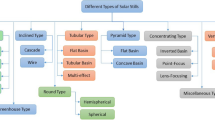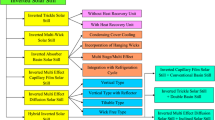Abstract
With the increasing demand for clean and fresh drinking water, there is a growing interest and necessity for the development of water distillation systems that incorporate green technologies. In light of this, the present research work focuses on the thermodynamic modelling and analysis of a newly conceptualized design called Double Basin Concentric Tubular Solar Stills (DBCTSS). The present investigation considers essential thermodynamic performance parameters that are applicable to any solar-based water distillation system. These parameters include the glass cover temperature, basin water temperature, basin temperature, daily yield of freshwater distillate, modified convective, evaporative, and radiative heat transfer coefficients, cumulative yield, energy efficiency, and exergy efficiency. The research investigates the individual and combined effects of the upper basin and lower basin effect by using performance perimeters. The results demonstrate that both the first and second basin effects affirm the superiority of the proposed DBCTSS design. The total yield achieved by this system is 6.424 kg/m2, which represents a 51.86% increase compared to the experimental work conducted on a conventional tubular solar still that utilizes sand as the energy storage material (CTSS with sand). Furthermore, the maximum thermal efficiency for the first and second basin effects is found to be 60.053% and 37.48%, respectively. Similarly, the exergy efficiency values are determined to be 5.092% and 2.1%, respectively.










Similar content being viewed by others
Abbreviations
- \(h_{tl1}\) :
-
Total loss coefficient for first basin effect (W/m2 K)
- \(U_{tl1}\) :
-
Overall total loss coefficient for first basin effect (W/m2 K)
- \(h\) :
-
Heat transfer coefficient (W/m2 K)
- \(U_{sl}\) :
-
Overall side loss coefficient (W/m2 K)
- \(U_{bl }\) :
-
Overall bottom loss coefficient (W/m2 K)
- \(U_{tl2}\) :
-
Overall total loss coefficient for second basin effect (W/m2 K)
- \(h_{t2}\) :
-
Total heat transfer coefficient for second basin effect (W/m2 K)
- \(h_{fg}\) :
-
Enthalpy of vaporization (kJ/kg)
- \(g\) :
-
Glass
- \(w\) :
-
Water
- \(\eta_{s}\) :
-
Thermal efficiency
- \(\eta_{exr}\) :
-
Exergy efficiency
- \(r\) :
-
Radiative
- \(c\) :
-
Convective
- \(e\) :
-
Evaporative
- \(L\) :
-
Thickness (m)
- \(q_{y}\) :
-
Amount of energy produced due to temperature difference (W/m2)
- \(T\) :
-
Temperature (°C)
- \(\alpha\) :
-
Absorbtivity
- \(R\) :
-
Reflectivity
- \(\tau\) :
-
Transmissivity
- \(\in \) :
-
Emmisivity
- \(Gr\) :
-
Grashoff number
- \(\beta\) :
-
Coefficient of thermal expansion (1/°C)
- \(\mu\) :
-
Dynamic viscosity kg/m s
- \(\rho\) :
-
Density (kg/m3)
- \(Pr\) :
-
Prandtl number
- Cp:
-
Specific heat (kJ/kg K)
- \(\sigma\) :
-
Stefan Boltzmann constant W/m2 k4
- \(go - a\) :
-
Outer glass covers to ambient
- \(gi - a\) :
-
Inner glasses cover to ambient
- \(w - g\) :
-
Water to glass
- \(b_{1} - w_{1 }\) :
-
Basin to water for upper basin effect
- \(b_{1} - g_{i,2 }\) :
-
Basin of upper basin effect to inner glass cover of lower basin effect
- \(b_{2} - w_{2 }\) :
-
Basin to water for lower basin effect
- \(b2 - a\) :
-
Basin of lower basin effect to ambient
- \(b2 - gi2\) :
-
Basin of lower basin effect to glass of lower basin effect
- \(g2 - gi1\) :
-
Glass of lower of lower basin effect to glass of upper basin effect
- \(b1 - a\) :
-
Basin of upper basin effect to ambient
- \(b1 - gi2\) :
-
Basin of upper basin effect to inner glass cover of upper basin effect
- \(b2 - a\) :
-
Basin of lower basin effect to ambient
- \(b1 - gi2\) :
-
Basin of upper basin effect to inner glass cover of lower basin effect
- \(go1 - a\) :
-
Outer glass covers of first basin effect to ambient
- \(ins\) :
-
Insulation
- DBCTSS:
-
Double basin concentric tubular solar still
- CTSS:
-
Concentric tubular solar still
- TSS:
-
Tubular solar still
- PCM:
-
Phase change material
- NPCM:
-
Nano-phase change material
- SSOSS:
-
Single slope ordinary solar still
References
Arani, R.P., Sathyamurthy, R., Chamkha, A., Kabeel, A.E., Deverajan, M., Kamalakannan, K., Balasubramanian, M., Athikesavan, K., Manokar, M.: Effect of fins and silicon dioxide nanoparticle black paint on the absorber plate for augmenting yield from tubular solar still. Environ. Sci. Pollut. Res. 28, 35102–35112 (2021). https://doi.org/10.1007/s11356-021-13126-y
Chaurasiya, P.K., Rajak, U., Singh, S.K., Nath Verma, T., Sharma, V.K., Kumar, A., Shende, V.: A review of techniques for increasing the productivity of passive solar stills. Sustain. Energy Technol. Assess. 5, 2 (2022). https://doi.org/10.1016/j.seta.2022.102033
Cooper, P.I.: The absorption of radiation in solar stills. Sol. Energy 19, 333 (1969)
Dunkle, R.V.: Solar water distillation: the roof of type still and multiple effect diffusion still, international developments in heat transfer. In: ASME Proceedings of the International Heat Transfer, Part V, University of Colorado, p. 89 (1961)
Elshamy, S.M., El-Said, E.M.S.: Comparative study based on thermal, exergetic and economic analyses of a tubular solar still with semi-circular corrugated absorber. J. Clean. Prod. 195, 328–339 (2018). https://doi.org/10.1016/j.jclepro.2018.05.243
Essa, F.A., Abdullah, A.S., Omara, Z.M.: Improving the performance of tubular solar still using rotating drum—experimental and theoretical investigation. Process Saf. Environ. Prot. 148, 579–589 (2021). https://doi.org/10.1016/j.psep.2020.11.039
Kabeel, A.E., Abdelgaied, M.: Observational study of modified solar still coupled with oil serpentine loop from cylindrical parabolic concentrator and phase changing material under basin. Sol. Energy 144, 71–78 (2017). https://doi.org/10.1016/j.solener.2017.01.007
Kabeel, A.E., El-Agouz, S.A., Sathyamurthy, R., Arunkumar, T.: Augmenting the productivity of solar still using jute cloth knitted with sand heat energy storage. Desalination 443, 122–129 (2018). https://doi.org/10.1016/j.desal.2018.05.026
Murali, B., Krishnamoorthy, N., Manoj Kumar, P., Saravanan, M., Madankumar, D., Surakasi, R., Sharma, A., Sudhakar, M.: Design and performance optimization of a solar still using Nano-Coated Condensing Glass. Int. J. Interact. Des. Manuf. (2022). https://doi.org/10.1007/s12008-022-01168-6
Murugavel, K.K., Sivakumar, S., Ahamed, J.R., Chockalingam, K.K.S.K., Srithar, K.: Single basin double slope solar still with minimum basin depth and energy storing materials. Appl. Energy 87(2), 514–523 (2010). https://doi.org/10.1016/j.apenergy.2009.07.023
Nagrale, P., Dewangan, S.K.: Mathematical modelling and analysis of thermodynamic performance parameters of tubular solar still. Energy Sources A Recov. Util. Environ. Eff. 44(3), 6129–6152 (2022). https://doi.org/10.1080/15567036.2022.2095464
Rajaseenivasan, T., Murugavel, K.: Theoretical and experimental investigation on double basin double slope solar still. Desalination 319, 25–32 (2013). https://doi.org/10.1016/j.desal.2013.03.029
Sambare, R.K., Dewangan, S.K., Gupta, P.K., Joshi, S.: Energy, exergy and economic analyses of tubular solar still with various transparent cover materials. Process Saf. Environ. Prot. 168, 1101–1108 (2022). https://doi.org/10.1016/j.psep.2022.10.064
Sambare, R.K., Dewangan, S.K., Gupta, P.K., Joshi, S.: Augmenting the productivity of tubular solar still using low-cost energy storage materials. Environ. Sci. Pollut. Res. 29(52), 78739–78756 (2022). https://doi.org/10.1007/s11356-022-21324-5
Sivakumar, V., Sundaram, E.G., Sakthivel, M.: Investigation on the effects of heat capacity on the theoretical analysis of single slope passive solar still. Desalin. Water Treat. 57(20), 9190–9202 (2016). https://doi.org/10.1080/19443994.2015.1026284
Thalib, M.M., Manokar, A.M., Essa, F.A., Vasimalai, N., Sathyamurthy, R., Garcia Marquez, F.P.: Comparative study of tubular solar stills with phase change material and nano-enhanced phase change material. Energies 13(15), 1–13 (2020). https://doi.org/10.3390/en13153989
Tiwari, A.K., Tiwari, G.N.: Thermal modelling based on solar fraction and experimental study of the annual and seasonal performance of a single slope passive solar still: the effect of water depths. Desalination 207(1–3), 184–204 (2007). https://doi.org/10.1016/j.desal.2006.07.011
Tiwari, G.N., Minocha, A., Sharma, P.B., Emran Khan, M.: Simulation of convective mass transfer in a solar distillation process. Energy Convers. Manag. 38(8), 761–770 (1997)
Wang, L., Wood, R.J.K.: The influence of contact conditions on surface reaction layers formed between steel surfaces lubricated by aviation oil. Sol. Energy 81(12), 1482–1491 (2007). https://doi.org/10.1016/j.solener.2007.02.005
Zheng, H., Chang, Z., Chen, Z., Xie, G., Wang, H.: Experimental investigation and performance analysis on a group of multi-effect tubular solar desalination devices. Desalination 311, 62–68 (2013). https://doi.org/10.1016/j.desal.2012.11.021
Zurigat, Y.H., Abu-Arabi, M.K.: Modelling and performance analysis of a regenerative solar desalination unit. Appl. Therm. Eng. 24(7), 1061–1072 (2004). https://doi.org/10.1016/j.applthermaleng.2003.11.010
Acknowledgements
This work is supported by the National Institute of Technology Raipur (CG), which has provided both online and offline research resources.
Author information
Authors and Affiliations
Corresponding author
Ethics declarations
Conflict of interest
No potential conflict of interest is reported by the authors in relation to communicating and publishing this research work.
Additional information
Publisher's Note
Springer Nature remains neutral with regard to jurisdictional claims in published maps and institutional affiliations.
Rights and permissions
Springer Nature or its licensor (e.g. a society or other partner) holds exclusive rights to this article under a publishing agreement with the author(s) or other rightsholder(s); author self-archiving of the accepted manuscript version of this article is solely governed by the terms of such publishing agreement and applicable law.
About this article
Cite this article
Pal, S., Dewangan, S.K. Thermodynamic modeling and performance analysis of newly conceptualized Double basin concentric tubular solar still. Int J Interact Des Manuf 18, 55–69 (2024). https://doi.org/10.1007/s12008-023-01393-7
Received:
Accepted:
Published:
Issue Date:
DOI: https://doi.org/10.1007/s12008-023-01393-7




